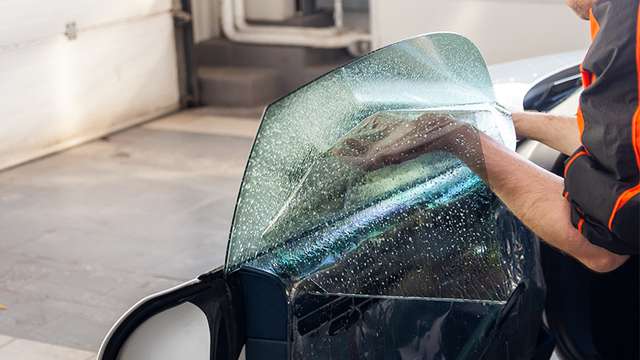- window tinting
What Is Car Window Tinting & How Does It Work

Updated 9 Nov 2023
Rachel White

Window tinting is a scratch-resistant thin film, usually made from a polyester base, that adheres to the inside of car windows.
The purpose of tinting isn’t only to make it hard to see into a car and make it more appealing - there are some more logical and beneficial reasons to consider this modification.
Benefits of car window tinting
- UV rays - those harmful UV rays can be a killer if you’re stuck in the car in the daytime. Some window tints will block harmful UV rays, keeping you safer when driving. Ideally, all work vehicles should have UV protection
- Privacy - the windscreen of a vehicle cannot legally have a dark tint applied, but the rear of the vehicle can. This provides some privacy and may deter those dastardly thieves when they can’t see what is inside
- Glare - night and daytime glare can be reduced
- Cooler - With less UV and sunlight entering the vehicle, tints can keep the car cooler.
- Aesthetics - some people see tinting as a ‘must-have look’ for their car. That’s completely subjective of course but, for them, the car looks undressed unless it has that tinted glaze.
Types of car window tints
There are various shades and types of tints on the market and each should be considered based on your needs. Some laws and regulations apply to car window tinting - particularly around visibility - so it’s a good idea to do some homework on which will work for you.
Dyed Film
This is the most widely used type as it’s durable and the most cost-effective option. It will provide that tinted look, and decent visibility and block a percentage of sunlight from the car. However, it doesn’t provide the best UV protection or heat resistance, and that leads to decolourisation over time.
Crystalline
This type has some of the benefits of tint - will block UVs and heat but doesn’t have a darker appearance.
Metallised Film
The metal particles within the film will redirect light and aid in UV protection. This type of tint, which can have a shiny appearance, is resistant to fading, is durable and helps to strengthen the window. Be aware that this tint may interfere with phone and radio signals.
Hybrid Film
This type is great at reflecting heat and UV rays, is less fade-resistant, durable, and won’t interfere with equipment signals.
Carbon Film
If you want your car to look good this may be the tint for you. With UV protection, sleek appearance and also offers great reductions in solar heat. Could it get any better?
Ceramic Film
Yes, it can get better. This is the bee's knees of window tint, offering UV protection, reduced glare, massive reductions in solar heat and good visibility. It does come at a price, of course.
Some window tinters have computerised cutters that will precut the tint based on your specific vehicle. Others may cut the film at the time of application. This is generally how a tint is applied:
- The inside of the windows are thoroughly cleaned
- The outside of the window will be used to shape, cut and prepare the film
- A heat gun and card will be used to remove any air bubbles within the film
- The film will be moved to the inside of the window where an application of soapy water will help the tint to be moved into position
- A hard edge will be used to squeegee out any water caught between the window and the film until all is clear
Once you know what type of window tint is best for you, book with an AutoGuru expert window tinter to get the cleanest clear-cut tint.
How is car window tint applied?
Some window tinters have computerised cutters that will precut the tint based on your specific vehicle. Others may cut the film at the time of application. This is generally how a tint is applied:
- The inside of the windows are thoroughly cleaned
- The outside of the window will be used to shape, cut and prepare the film
- A heat gun and card will be used to remove any air bubbles within the film
- The film will be moved to the inside of the window where an application of soapy water will help the tint to be moved into position
- A hard edge will be used to squeegee out any water caught between the window and the film until all is clear
Once you know what type of window tint is best for you, book with an AutoGuru expert window tinter to get the cleanest clear-cut tint.

Written By
Rachel White
Rachel spent her early adult life around cars, motorsport and hands-on with her own cars. This interest moved into various careers within the Automotive industry. Joined with her passion for writing, Rachel loves putting the two together to share her experience, so we can all become AutoGuru’s.